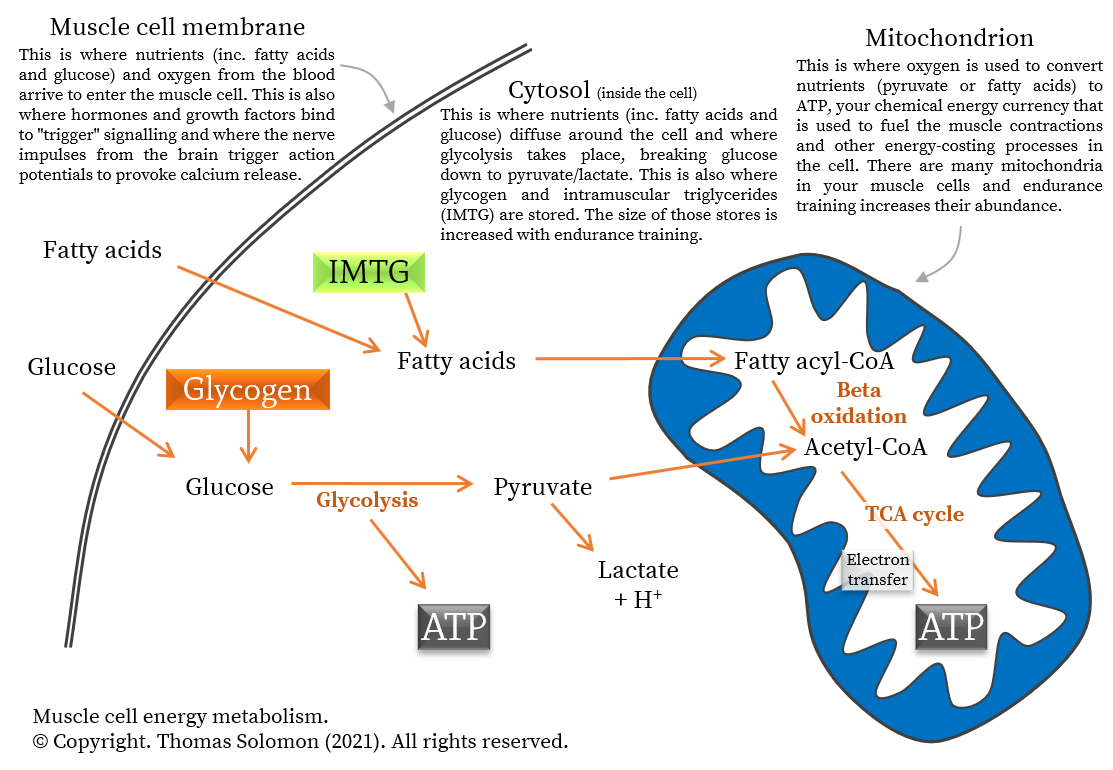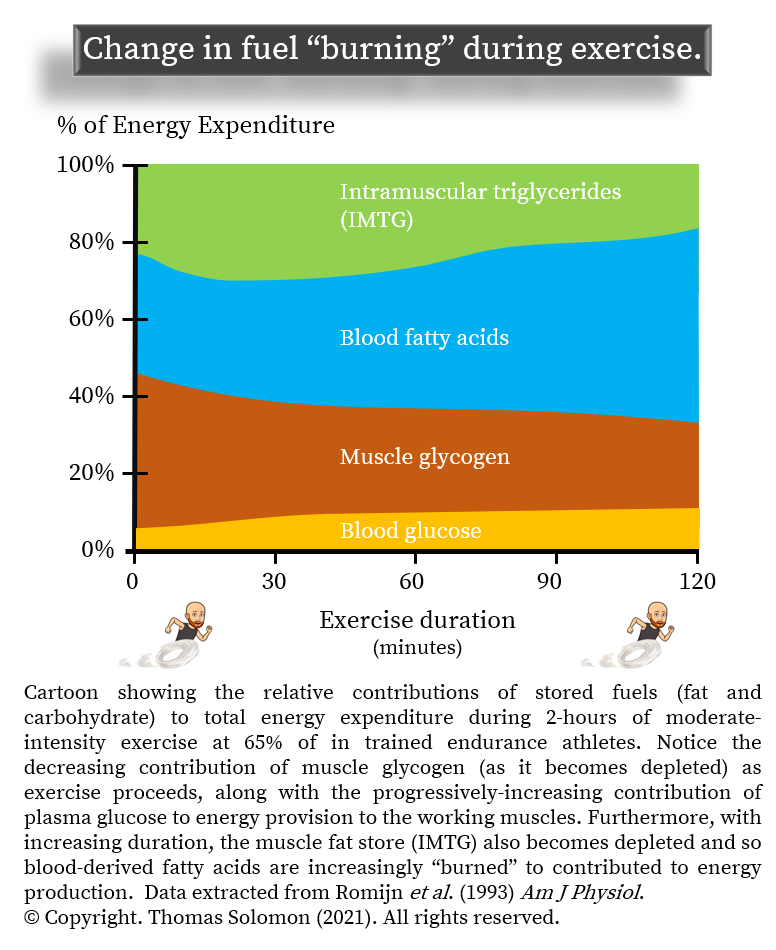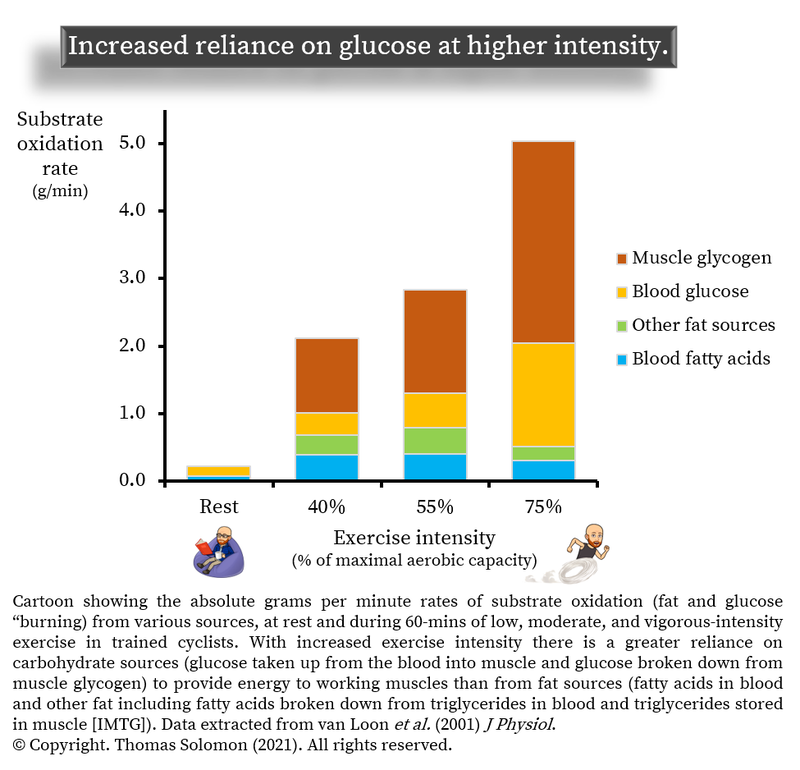Education for runners and endurance athletes. Learn to train smart, run fast, and be strong.
These articles are free.
Please help keep them alive by buying me a beer:
 Buy me a beer.
Buy me a beer.
This article is part of a series:
→ Part 1 — How much fuel is in your body?
→ Part 2 — How do your muscles burn fuel?
→ Part 3 — How long can you go?
→ Part 4 — Carboloading
→ Part 5 — Race day carb availability
→ Part 6 — Putting it into practice
→ Part 1 — How much fuel is in your body?
→ Part 2 — How do your muscles burn fuel?
→ Part 3 — How long can you go?
→ Part 4 — Carboloading
→ Part 5 — Race day carb availability
→ Part 6 — Putting it into practice
Performance nutrition: Part 2 of 6:
How do your muscles use fuel to produce energy during exercise?
Thomas Solomon PhD.
15th May 2021.
In part 1 of this series, you learnt how your organ systems fit together, how much fuel you have available in your body, and how metabolism can be measured. You are now ready to understand why the size of your bodily fuel stores, aka your “bucket load of fatty acids and pint-glass of glucose”, are so relevant to performance.
Reading time ~8-mins (1500-words).
Or listen to the Podcast version.
Or listen to the Podcast version.
If your body stores lots of fat but little carbohydrate, it is useful to know how these fuels are “burned” during exercise because this will help you understand how to optimise your performance. As you embark on your journey into the world of substrate oxidation, there is an obvious question to ask yourself...
 The increase in your rate of energy expenditure (kcals per minute) is proportional to the increase in your work rate (intensity);
The increase in your rate of energy expenditure (kcals per minute) is proportional to the increase in your work rate (intensity);
and,
 The total amount of energy used (kcals) is proportional to your total duration of work (minutes).
The total amount of energy used (kcals) is proportional to your total duration of work (minutes).
During physical work (exercise), the kcals (or kiloJoules) predominantly come from fatty acids and glucose. Your muscles “burn” fatty acids taken up from those circulating in the blood and those broken down from fat droplets stored in your muscle cells (aka intramyocellular triglycerides, IMTG). Your muscles also “burn” glucose taken up from the blood and glucose broken down from glycogen stored within muscles. Within your muscle cells, chemical energy (ATP) is generated from fatty acids and glucose by oxygen-requiring (aka aerobic) oxidative processes in the mitochondria plus a little bit coming from glucose via non-oxygen-requiring (aka anaerobic) non-oxidative processes outside the mitochondria. Compared to regular folks, endurance athletes have adapted to store large amounts of IMTG and glycogen in their muscles and they have adapted to store the majority of their IMTG and glycogen right where they are needed; next to the mitochondria. Plus, endurance athletes have more mitochondria and higher activities of their metabolic enzymes, allowing athletes to produce more energy, more efficiently than regular folks.
Pretty darn cool.

How do we know this?
The first observations that the body “burns” different proportions of fat and carbohydrate to produce energy during exercise, was made in 1920 by August Krogh and Johannes Lindhard. Much subsequent work added to our knowledge but in the 1990s, a series of highly-detailed mechanistic studies from the labs of Bob Wolf (Romijn et al. 1993) and Anton Wagenmakers (van Loon et al. 1999 and van Loon et al. 2001) used stable isotopes of glucose and palmitate (a fatty acid), combined with indirect calorimetry, and tissue biopsies, to measure whole-body and tissue-specific glucose and fatty acid “flux” (aka, the rate of transport from the blood into tissues and vice versa) and “oxidation” (aka the rate of burning) during low-, moderate-, and high-intensity exercise in trained cyclists and untrained folks.
These studies firstly showed that the high level of adipose tissue lipolysis (aka fat breakdown in fat tissue) does not further increase with increasing exercise intensity (from low, 25% VO2max, to high, 85% VO2max) but intramuscular lipolysis (aka fat, or IMTG, breakdown in muscle) does. However, adipose tissue release of fatty acids into blood decreases with increasing exercise intensity, causing reduced availability of fatty acids in the blood at higher exercise intensities. This might imply that the decrease in fat “burning” with increasing exercise intensity is possibly due to the lower amounts of fatty acids available in the blood. That aside, the decrease in fatty acid availability with increasing exercise intensity is compensated for by an increase in glucose availability, as shown by increasing glucose appearance into the blood (from the liver) with increasing exercise intensity, and a corresponding increase in glucose “burning”.
Say whaaat?
To summarise that rant:
 Your body always makes fuel available to the working muscle to support the increasing energy requirement as exercise intensity increases,
Your body always makes fuel available to the working muscle to support the increasing energy requirement as exercise intensity increases,
and
 There is an intensity-dependent change in the relative contribution of different types of fuel (from fatty acids to glucose) as exercise intensity increases.
There is an intensity-dependent change in the relative contribution of different types of fuel (from fatty acids to glucose) as exercise intensity increases.
Next, it was found that during prolonged exercise (2-hours), blood glucose is used to produce energy at low (25% VO2max, aka a walk), moderate (65% VO2max, aka an easy run), and high (85% VO2max, aka a marathon-paced run) intensities. Over a 2-hour moderate-intensity bout, for example, blood glucose use and blood fatty acid use progressively increase while muscle glycogen and muscle fat (IMTG) use decrease (because the muscles’ available glycogen and IMTG stores become depleted).
The important take-home from that is:
 Your muscles always use blood glucose even during low-intensity exercise, putting pressure on the liver to release enough glucose to prevent hypoglycemia (low blood sugar).
Your muscles always use blood glucose even during low-intensity exercise, putting pressure on the liver to release enough glucose to prevent hypoglycemia (low blood sugar).
This means that:
 Endurance training causes “fat adaptation” to help spare your precious glycogen stores during exercise… But, you probably already knew that.
Endurance training causes “fat adaptation” to help spare your precious glycogen stores during exercise… But, you probably already knew that.
Finally, this series of studies showed that as a trained athlete makes the transition from moderate to high-intensity exercise (roughly the equivalent as transitioning from your easy run pace to your marathon pace), fatty acid oxidation rates (fat “burning”) decrease while glucose oxidation (glucose “burning” of glucose taken up from the blood and glucose broken down from muscle glycogen) increase. These observations contribute to those which led to George Brooks’ “crossover concept”, the point at which you switch from predominantly fat to predominantly carbohydrate use during increasing intensity exercise (read more about that in a previous post at veohtu.com/fatoxidationrates). Furthermore, these studies found that the decrease in fat “burning” is explained by a decrease in the use of fatty acids freely circulating in the blood, and fatty acids broken down from triglycerides circulating in the blood, and fatty acids broken down from triglycerides stored in muscle (IMTG). Plus, with increasing intensity, the activity of the enzyme (called CPT1) that shuttles fatty acids into the muscles’ mitochondria so they can be “burned” was also found to be decreased. In other words, fatty acid delivery to the mitochondria (the part of the muscle cell that “burns” fat to produce energy) is decreased as exercise intensity increases.
 Increasing your intensity during exercise — moving faster — will increase your muscles’ reliance on glucose to produce energy.
Increasing your intensity during exercise — moving faster — will increase your muscles’ reliance on glucose to produce energy.
and
 Because your muscles always “burn” glucose, even during low exercise intensity, long-duration exercise will eventually deplete available glucose stored in your body.
Because your muscles always “burn” glucose, even during low exercise intensity, long-duration exercise will eventually deplete available glucose stored in your body.
This knowledge might prompt an obvious question: How long will your bodily fuel stores allow you to go?
Well, tune in for the next part of this series to find out.
Until then, keep training smart…
How does your body use its stored fuels during exercise?
At rest, your body “drip-feeds” energy from its fuel stores to keep all your basic functions plodding along. The amount of energy you “burn” at rest is your resting metabolic rate (your RMR). When you get up and start moving, the rate at which energy is used increases above your resting metabolic rate and this increase is relative to the rate of work (or intensity) of your movement. For example, when you stand up there, is a small increase in your energy expenditure above resting levels; when you walk slowly (~3 kph), there is about a 2-fold increase in energy expenditure; a 10-fold increase if you run at 10 kph; and about a 20-fold increase if you run at 10 kph up a 10% incline. You can conceptualise this as follows:and,
Pretty darn cool.

×
![]()
But it gets a little more complicated than that because as your rate of work increases, different types of fuel are preferentially used to produce the energy you need. It is like fatty acids and glucose start competing to be the ones that are “burned” — “I want to jump in the fire!” … “No. I want to jump in the fire!” … Weirdos.
How do we know this?
The first observations that the body “burns” different proportions of fat and carbohydrate to produce energy during exercise, was made in 1920 by August Krogh and Johannes Lindhard. Much subsequent work added to our knowledge but in the 1990s, a series of highly-detailed mechanistic studies from the labs of Bob Wolf (Romijn et al. 1993) and Anton Wagenmakers (van Loon et al. 1999 and van Loon et al. 2001) used stable isotopes of glucose and palmitate (a fatty acid), combined with indirect calorimetry, and tissue biopsies, to measure whole-body and tissue-specific glucose and fatty acid “flux” (aka, the rate of transport from the blood into tissues and vice versa) and “oxidation” (aka the rate of burning) during low-, moderate-, and high-intensity exercise in trained cyclists and untrained folks.
These studies firstly showed that the high level of adipose tissue lipolysis (aka fat breakdown in fat tissue) does not further increase with increasing exercise intensity (from low, 25% VO2max, to high, 85% VO2max) but intramuscular lipolysis (aka fat, or IMTG, breakdown in muscle) does. However, adipose tissue release of fatty acids into blood decreases with increasing exercise intensity, causing reduced availability of fatty acids in the blood at higher exercise intensities. This might imply that the decrease in fat “burning” with increasing exercise intensity is possibly due to the lower amounts of fatty acids available in the blood. That aside, the decrease in fatty acid availability with increasing exercise intensity is compensated for by an increase in glucose availability, as shown by increasing glucose appearance into the blood (from the liver) with increasing exercise intensity, and a corresponding increase in glucose “burning”.
Say whaaat?
To summarise that rant:
and
The important take-home from that is:
×
![]()
Next, if an endurance-trained athlete and an untrained person complete a prolonged (2-hour) workout at the same absolute workload as (e.g. both riding at 150 watts or running at 12 kph), total energy burned (kcals per hour) is about the same but the trained folks “burn” way more fat and way less glucose. In fact, the lower glucose oxidation rate in a trained athlete is explained by a lesser reliance on muscle glycogen use and (liver-derived) blood glucose use.
This means that:
×
![]()
What can you put in your performance nutrition toolbox?
So, coming back to that question: How does your body use its stored fuels — its bucket load of fatty acids and pint-glass of glucose — during exercise? … The important nuggets of my rant to embed in your cerebellum are that:and
Until then, keep training smart…
Disclaimer: I occasionally mention brands and products but it is important to know that I am not affiliated with, sponsored by, an ambassador for, or receiving advertisement royalties from any brands. I have conducted biomedical research for which I have received research money from publicly-funded national research councils and medical charities, and also from private companies, including Novo Nordisk Foundation, AstraZeneca, Amylin, A.P. Møller Foundation, and Augustinus Foundation. I’ve also consulted for Boost Treadmills and Gu Energy on their research and innovation grant applications and I’ve provided research and science writing services for Examine — some of my articles contain links to information provided by Examine but I do not receive any royalties or bonuses from those links. These companies had no control over the research design, data analysis, or publication outcomes of my work. Any recommendations I make are, and always will be, based on my own views and opinions shaped by the evidence available. My recommendations have never and will never be influenced by affiliations, sponsorships, advertisement royalties, etc. The information I provide is not medical advice. Before making any changes to your habits of daily living based on any information I provide, always ensure it is safe for you to do so and consult your doctor if you are unsure.
If you find value in this free content, please help keep it alive and buy me a beer:
 Buy me a beer.
Buy me a beer.
Share this post on your social media:
Want free exercise science education delivered to your inbox? Join the 100s of other athletes, coaches, students, scientists, & clinicians and sign up here:

About the author:
I am Thomas Solomon and I'm passionate about relaying accurate and clear scientific information to the masses to help folks meet their fitness and performance goals. I hold a BSc in Biochemistry and a PhD in Exercise Science and am an ACSM-certified Exercise Physiologist and Personal Trainer, a VDOT-certified Distance running coach, and a Registered Nutritionist. Since 2002, I have conducted biomedical research in exercise and nutrition and have taught and led university courses in exercise physiology, nutrition, biochemistry, and molecular medicine. My work is published in over 80 peer-reviewed medical journal publications and I have delivered more than 50 conference presentations & invited talks at universities and medical societies. I have coached and provided training plans for truck-loads of athletes, have competed at a high level in running, cycling, and obstacle course racing, and continue to run, ride, ski, hike, lift, and climb as much as my ageing body will allow. To stay on top of scientific developments, I consult for scientists, participate in journal clubs, peer-review papers for medical journals, and I invest every Friday in reading what new delights have spawned onto PubMed. In my spare time, I hunt for phenomenal mountain views to capture through the lens, boulder problems to solve, and for new craft beers to drink with the goal of sending my gustatory system into a hullabaloo.
Copyright © Thomas Solomon. All rights reserved.
I am Thomas Solomon and I'm passionate about relaying accurate and clear scientific information to the masses to help folks meet their fitness and performance goals. I hold a BSc in Biochemistry and a PhD in Exercise Science and am an ACSM-certified Exercise Physiologist and Personal Trainer, a VDOT-certified Distance running coach, and a Registered Nutritionist. Since 2002, I have conducted biomedical research in exercise and nutrition and have taught and led university courses in exercise physiology, nutrition, biochemistry, and molecular medicine. My work is published in over 80 peer-reviewed medical journal publications and I have delivered more than 50 conference presentations & invited talks at universities and medical societies. I have coached and provided training plans for truck-loads of athletes, have competed at a high level in running, cycling, and obstacle course racing, and continue to run, ride, ski, hike, lift, and climb as much as my ageing body will allow. To stay on top of scientific developments, I consult for scientists, participate in journal clubs, peer-review papers for medical journals, and I invest every Friday in reading what new delights have spawned onto PubMed. In my spare time, I hunt for phenomenal mountain views to capture through the lens, boulder problems to solve, and for new craft beers to drink with the goal of sending my gustatory system into a hullabaloo.
Copyright © Thomas Solomon. All rights reserved.


